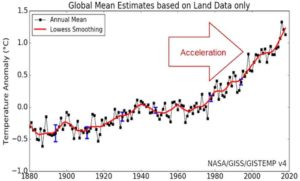The definition of insanity is doing the same thing over and over and expecting different results. – Albert Einstein.
As the world is trying to hopefully recover from the tragic effects of COVID-19, it is reminded there is no vaccine for the existential threat for its life support systems posed by global warming, nor for the looming threats of future wars and nuclear wars fueled by warmongers and $trillion preparations by military-industrial complexes.
Between 1740 and 1897 some 230 wars and revolutions in Europe suggested war remained deeply ingrained in the human psyche and civilization. The question is whether the currently approaching catastrophes can be averted.
No one wishes to believe in the projections made in the recent book ‘The Uninhabitable Earth’, except that these projections, made by David Wallace-Wells, are disturbingly consistent with the current shift in state of the climate toward +4 degrees and even +6 degrees Celsius above pre-industrial levels, as indicated by the current trends (Figure 1) and conveyed by leading climate scientists and the International Panel for Climate Change (IPCC).

Figure 1 – Global mean temperature estimates for land areas (NASA).
Facing the unthinkable consequences of global warming is pushing climate scientists into a quandary. In private conversations, many scientists express far greater concern at the trend of global warming than they do in public. However, faced with social and psychological barriers, as well as threats of losing positions and jobs, in business, public service and academia, a majority keeps silent, displaying lesser courage than school children.
According to James Hansen (2012), NASA’s former chief climate scientist: “You can’t burn all of these fossil fuels without creating a different planet”. According to Joachim Schellnhuber (2015), Germany’s chief climate scientist: ‘We’re simply talking about the very life support system of this planet’, and ‘If we don’t solve the climate crisis, we can forget about the rest’.
Referring to a phenomenon he termed “scientific reticence”, James Hansen (2007) states: “I suggest that a “scientific reticence” (namely a reluctance to convey worrying news) is inhibiting the communication of a threat of a potentially large sea level rise”.
According to Bajaj (2019): “when it comes to climate change, the need for excessive caution and absolute certainty of the results is manifesting as silence from the mainstream science on the worst yet probable consequences and the worst-case scenarios that are looking increasingly likely”. A paradox emerges where scientists who experience scientific reticence are still accused of being alarmists.
This is because an evaluation of the probability of a risk needs to be related to the magnitude of the risk. For example, the inspection of the engines of a Jumbo Jet carrying 300 passengers need to be even more rigorous than that of a commuter van, or evaluation of the risk posed by a potential failure of a nuclear reactor even more critical than that of a conventional power plant, as is the absolute safety of a particle accelerator.
By analogy with the dictum “Those who do not learn from history are doomed to repeat it” projections of future climate trajectories need to take account of studies of the past behaviour of the atmosphere-ocean system. The pace of current global warming exceeds those of the last 2.6 million years by an order of magnitude, with calamitous consequences for biological systems.
As indicated by the basic laws of physics, the principles of climate science and empirical observations in nature, under an increase of greenhouse gas concentrations by about 50 percent , global warming is inevitable. While modeled future climate change trajectories may vary, depending whether observations are based on recent measurements, paleoclimate data or models, the consequences of such an increase are inevitably catastrophic. Whereas IPCC models portray linear warming trends to 2300, other models take account of the flow of ice melt water from Greenland and Antarctica into the oceans and thereby irregular warming (Glikson, 2019).
Given the warnings issued by leading climate scientists and the IPCC, while nations keep investing their dwindling $trillions in its military-industrial complexes in preparations for future war/s, our world is losing its last chance to save its planetary life support systems.
Dr Andrew Glikson Earth and Climate scientist






